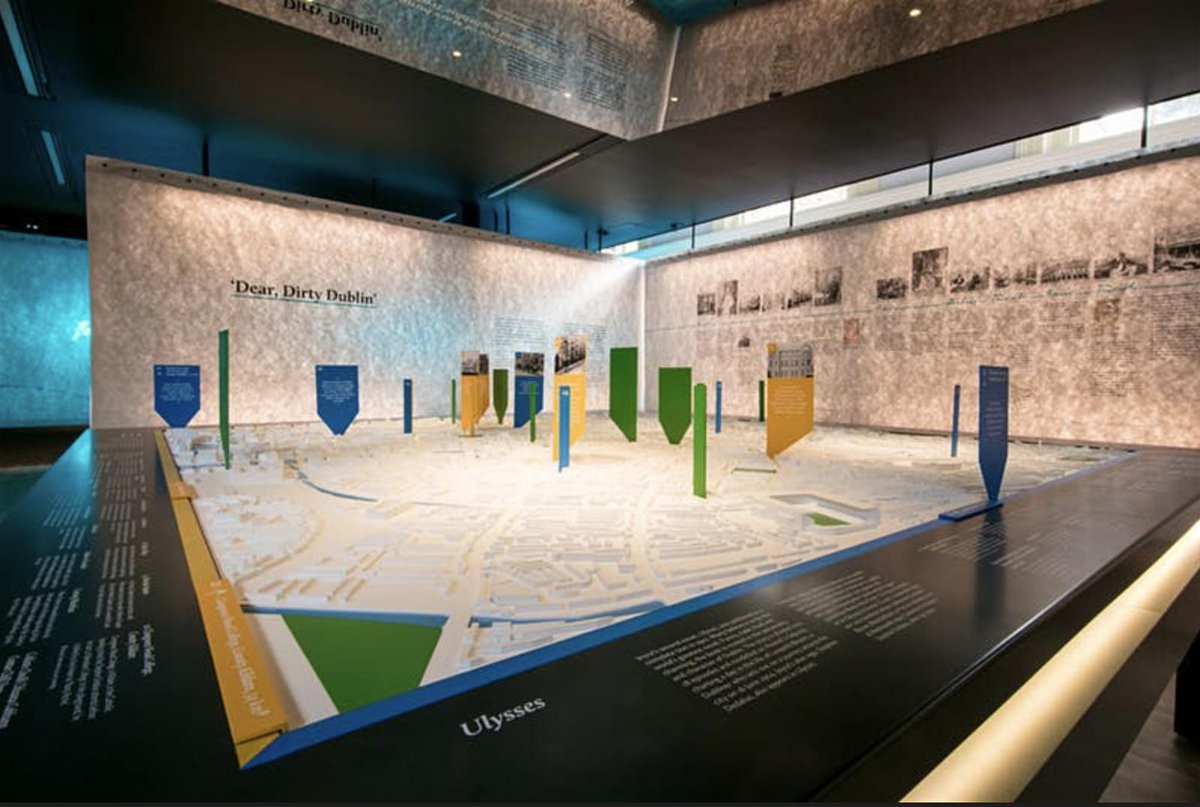The Museum of Literature Ireland (MoLI), which opened on Culture Night this September, is sure to become one of the city’s most popular cultural institutions for residents and tourists alike. Housed in UCD’s Newman House on St. Stephen’s Green, MoLI is a collaboration between the university and the National Library of Ireland. It focuses on James Joyce and lets him guide visitors through 100 years of Irish literature. The first room surrounds you with the words and faces of Ireland’s most prolific writers and poses the question, “So what makes Irish writers so special? Is it how we follow the rules, or how we break them?” The spaces that follow seek to answer that question and reflect on how Irish writers reinvented the rules of literature over and over again, as they continue to do today.
Kate O’Brien is featured in the next room in a rotating exhibit curated by her grand-niece Kathy Rose O’Brien. The space is intimate, so even if you’re not familiar with her work, her stories come alive around you. As an old-fashioned radio plays in the background, visitors can sit at O’Brien’s old school desk or recreate a famous café scene from her novel Mary Lavelle. A recurring theme in the museum is censorship and rebellion, and O’Brien embodied both as a journalist by writing about many controversial topics including women’s rights and environmental issues. The director of the museum, Simon O’Connor, said the decision to open with a female writer was because “What people might expect a museum of literature Ireland to be could be quite reductive…” He also added that visitors can expect an exhibit on Nuala O’Faolain once the space turns over.
“One of the featured films is a short version of Joyce’s Finnegan’s Wake, which O’Connor justified as an innovative way to bring people into ‘the language of the novel..’”
MoLI is innovative in its use of audio-video elements, but the design has multiple functions. O’Connor noted a key challenge in curating a museum of literature to be reading itself, and by introducing interdisciplinary elements, audiences are more engaged. O’Connor says he has observed people spending much more time with authors and listening to the work than he can imagine them spending if they had to read the information as captions. One of the featured films is a short version of Joyce’s Finnegan’s Wake, which O’Connor justified as an innovative way to bring people into “the language of the novel and the spelling and the craic and the fun of the work.” These types of audio-visual components are especially exciting for visitors who may not be familiar with the Irish language and can hear it spoken, perhaps for the first time.
These modern elements also contribute to the museum’s effort to resist a sole focus on the past and to bring in younger audiences: “I think firing the museum into the heart of young people is really, really important. I think it’s actually the most important work that we’ll do.” This is evident in a section called Irish Writing Now: Young Adult Fiction, as it is a genre that, despite being on the rise in the last decade, is often dismissed. However, MoLI recognizes its ability to “give readers an insight into the real challenges facing young people in Ireland and around the world today.” The exhibit portrays how these works of fiction, fantasy, and science-fiction have a distinct connection to Ireland. O’Connor expressed how important it is to show visitors that “what they’re reading is in here and that we treat it seriously as an organisation.”
“As you step out into the Dublin streets…you can’t help but feel connected to the city in a new and prolific way.”
Finally, while surrounded by various editions of Joyce’s work, including “Copy No. 1 of Ulysses”, visitors are invited to “write the first line of your story.” Some visitors take this seriously, others are more interpretive. One child writes, “My dad looks like Oscar Wilde” and includes a drawing to support this claim. Among the dozens of languages, I spotted comics, favourite quotes, stories about carrying Ulysses through the Canadian woods, museum reviews (all positive), and the opening lines to many novels in progress.
It is impossible to leave this museum without being inspired to read or write. As you step out into the Dublin streets (after stopping in the lovely garden and grabbing a bite at the delicious café), you can’t help but feel connected to the city in a new and prolific way. Whatever your reading or writing ability, this museum will make you want to embrace literature with newfound excitement. You will be ahead of the curve when it’s at the top of every travel bloggers’ list in the next few months.






